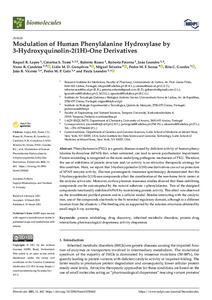Modulation of human phenylalanine hydroxylase by 3-hydroxyquinolin-2(1h)-one derivatives
Lopes, Raquel R.; Tomé, Catarina S.; Russo, Roberto; Paterna, Roberta; Leandro, João; Candeias, Nuno R.; Gonçalves, Lídia M.D.; Teixeira, Miguel; Sousa, Pedro M.F.; Guedes, Rita C.; Vicente, João B.; Gois, Pedro M.P.; Leandro, Paula (2021-03)
Lopes, Raquel R.
Tomé, Catarina S.
Russo, Roberto
Paterna, Roberta
Leandro, João
Candeias, Nuno R.
Gonçalves, Lídia M.D.
Teixeira, Miguel
Sousa, Pedro M.F.
Guedes, Rita C.
Vicente, João B.
Gois, Pedro M.P.
Leandro, Paula
03 / 2021
462
Julkaisun pysyvä osoite on
https://urn.fi/URN:NBN:fi:tuni-202105265455
https://urn.fi/URN:NBN:fi:tuni-202105265455
Kuvaus
Peer reviewed
Tiivistelmä
Phenylketonuria (PKU) is a genetic disease caused by deficient activity of human pheny-lalanine hydroxylase (hPAH) that, when untreated, can lead to severe psychomotor impairment. Protein misfolding is recognized as the main underlying pathogenic mechanism of PKU. Therefore, the use of stabilizers of protein structure and/or activity is an attractive therapeutic strategy for this condition. Here, we report that 3-hydroxyquinolin-2(1H)-one derivatives can act as protectors of hPAH enzyme activity. Electron paramagnetic resonance spectroscopy demonstrated that the 3-hydroxyquinolin-2(1H)-one compounds affect the coordination of the non-heme ferric center at the enzyme active-site. Moreover, surface plasmon resonance studies showed that these stabilizing compounds can be outcompeted by the natural substrate L-phenylalanine. Two of the designed compounds functionally stabilized hPAH by maintaining protein activity. This effect was observed on the recombinant purified protein and in a cellular model. Besides interacting with the catalytic iron, one of the compounds also binds to the N-terminal regulatory domain, although to a different location from the allosteric L-Phe binding site, as supported by the solution structures obtained by small-angle X-ray scattering.
Kokoelmat
- TUNICRIS-julkaisut [16944]
